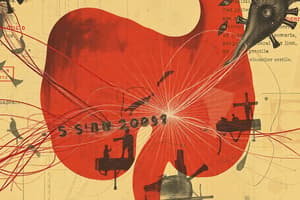Podcast
Questions and Answers
What initiates peristalsis in the GI tract?
What initiates peristalsis in the GI tract?
- Circular contraction
- Stretch of the gut wall (correct)
- Contraction of longitudinal muscle fibers
- Stimulation of intestinal villi
During peristalsis, what occurs behind the stimulus?
During peristalsis, what occurs behind the stimulus?
- Segmentation
- Circular contraction (correct)
- Relaxation
- Distension
At what speed can peristalsis propel the contents of the GI tract forward?
At what speed can peristalsis propel the contents of the GI tract forward?
- 1-5 cm/s
- 50-75 cm/s
- 10-20 cm/s (correct)
- 100-150 cm/s
How does peristaltic activity respond to autonomic input?
How does peristaltic activity respond to autonomic input?
What type of motility in the gastrointestinal tract is aimed at retarding the movement of intestinal contents?
What type of motility in the gastrointestinal tract is aimed at retarding the movement of intestinal contents?
How does removal and resuturing of a segment of intestine affect peristaltic progression?
How does removal and resuturing of a segment of intestine affect peristaltic progression?
What structure restricts reflux of colonic contents into the ileum?
What structure restricts reflux of colonic contents into the ileum?
What happens to the ileocecal valve under increases in conic pressure?
What happens to the ileocecal valve under increases in conic pressure?
What type of muscle controls the internal (involuntary) anal sphincter in humans?
What type of muscle controls the internal (involuntary) anal sphincter in humans?
Which nerve supplies the external anal sphincter?
Which nerve supplies the external anal sphincter?
What initiates the reflex contractions of the rectum musculature?
What initiates the reflex contractions of the rectum musculature?
At what rectal pressure does the urge to defecate typically first occur?
At what rectal pressure does the urge to defecate typically first occur?
What is the function of the intrinsic smooth muscle at the esophagogastric junction?
What is the function of the intrinsic smooth muscle at the esophagogastric junction?
What is the key feature of achalasia?
What is the key feature of achalasia?
Which condition is associated with reflux of gastric contents into the esophagus?
Which condition is associated with reflux of gastric contents into the esophagus?
What can severe cases of LES incompetence lead to?
What can severe cases of LES incompetence lead to?
What contributes to the prevention of regurgitation at the esophagogastric junction?
What contributes to the prevention of regurgitation at the esophagogastric junction?
What are the main symptoms associated with gastroesophageal reflux disease?
What are the main symptoms associated with gastroesophageal reflux disease?
What is the function of migrating motor complexes (MMCs) in the intestine?
What is the function of migrating motor complexes (MMCs) in the intestine?
How often does the entire cycle of migrating motor complexes (MMCs) under fasting conditions?
How often does the entire cycle of migrating motor complexes (MMCs) under fasting conditions?
What happens to migrating motor complexes (MMCs) when a meal is ingested?
What happens to migrating motor complexes (MMCs) when a meal is ingested?
Which part of the digestive system is responsible for breaking up large food particles and mixing the food with saliva?
Which part of the digestive system is responsible for breaking up large food particles and mixing the food with saliva?
Where are the cells located that are responsible for the pacemaker activity in the stomach and small intestine?
Where are the cells located that are responsible for the pacemaker activity in the stomach and small intestine?
How do peristaltic waves in the esophagus function?
How do peristaltic waves in the esophagus function?
What triggers the reflex response of swallowing (deglutition)?
What triggers the reflex response of swallowing (deglutition)?
Why do large food particles cause strong and often painful contractions of the esophageal musculature?
Why do large food particles cause strong and often painful contractions of the esophageal musculature?
What initiates the involuntary contraction in the pharyngeal muscles during swallowing?
What initiates the involuntary contraction in the pharyngeal muscles during swallowing?
Why are edentulous patients generally restricted to soft diets?
Why are edentulous patients generally restricted to soft diets?
What nerves carry efferent fibers to the pharyngeal musculature and the tongue during swallowing?
What nerves carry efferent fibers to the pharyngeal musculature and the tongue during swallowing?
Why do small food particles make swallowing difficult?
Why do small food particles make swallowing difficult?
Flashcards are hidden until you start studying




